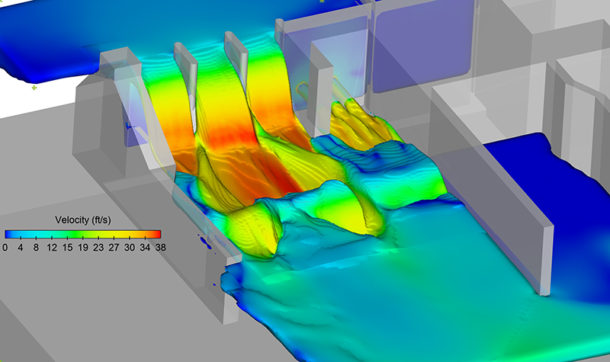CFD Hydraulic Modeling Helps Find Solutions to Dam Flow Problems
Today’s engineering challenges are complex, especially for dam owners and operators. Flow problems around dams include spillway scour, riprap damaging currents, river debris collecting in the wrong places, and uneven overtopping of training walls. Imbalanced flow entering powerhouse units can create trash rack vibrations, excessive bearing wear, and even air-core vortex formation. Before you invest significant construction and continual maintenance funds to repair these complex problems, dam owners and operators may want to consider reducing uncertainty and improving the project success with a computational fluid dynamics (or CFD for short) model.

About the Expert:
Pete Haug is a project manager in Ayres’ water resources group in Eau Claire, Wisconsin. His primary focus is on dam inspection, hydraulic structure design, and spillway construction observation. He is also an avid hydro surveyor. He is an instructor for Federal Highway Administration National Highway Institute classes (Highway Hydraulics, Culvert Design, and Urban Hydrology).
CFD modeling offers better understanding of root causes and possible solutions for flow problems near dams and power generation facilities. Engineers can use CFD modeling capabilities to solve energy dissipation problems, confirm root causes for uneven spillway scour patterns, and even model thermal currents. Engineers can model riverbed scour, sediment transport, waves, lake recirculation patterns, flow eddies, and even dynamic gate opening flows. If your project has a complex flow problem, the CFD numerical models might benefit your project by reducing maintenance and construction costs, reducing uncertainty of success, and getting your hydropower facility flowing smoothly again.
Check out this brief video to see CFD modeling in action.
What is CFD Modeling?
Beyond dams, CFD modeling is a practical way to predict and visualize how water flows in real-world conditions – including in rivers, stormwater structures, and wastewater systems. CFD solves fundamental flow equations that describe how physical laws govern fluid motion. It also provides detail and insight that 1D and 2D hydraulic models cannot deliver by resolving the flow in three directions. Simply put, CFD delivers the practical benefits of physical modeling in a reasonable time and budget.
In its early stages, and until recently, CFD was cost prohibitive and only used for very large projects to take advantage of its increased accuracy. But with technological advancement, the price has come down considerably, opening the door for smaller communities to take advantage of this cutting-edge analysis.
What About 1D and 2D Hydraulic Modeling?
1D and 2D hydraulic models are effective tools for large-scale, hydraulically straightforward applications. We have pioneered and championed 2D hydraulic modeling’s practical implementation, and it has become the method of choice for many design applications. However, 2D modeling is not the best solution for certain complex hydraulic problems.
In these cases, designers have historically either accepted undefined hydraulic uncertainly or have used physical modeling. High uncertainty requires conservative (potentially overbuilt) designs, or it could result in underperforming solutions. Physical models can be reliable but are often prohibitively expensive and time-consuming.
Examples of CFD’s Civil Engineering Applications
Of the many applications for CFD, here is a sampling related to civil engineering:
- Dam structures
- Aquatic organism passage (AOP)
- Decision-making demonstrations
- River features
- Sediment transport and scour
- Stormwater best management practice devices
- Stormwater structures
- Wastewater treatment systems
- Water treatment tanks and processes
What Are the Benefits of Computational Fluid Dynamics?
Four considerations impact the decision of which hydraulic model is the best match for a given project:
- Project risk and uncertainty
- Hydraulic complexity
- Design cost
- Design time
CFD isn’t going to make sense for every project, especially not if it’s simple, hydraulically speaking, and if the budget is limited. But for a complex project that comes with a lot of risk and uncertainty, CFD can be a more affordable option compared to physical scale models and full-scale prototypes, while also providing more data than 1D/2D hydraulic modeling. This means less impact on budget and a shorter design schedule while also reducing the uncertainty in the final design.
For more information on the benefits and uses of CFD modeling, check out this brochure.
For more information regarding CFD or the hydraulic engineering services we offer at Ayres, please contact Pete Haug, PE.

 By
By
Post a comment: